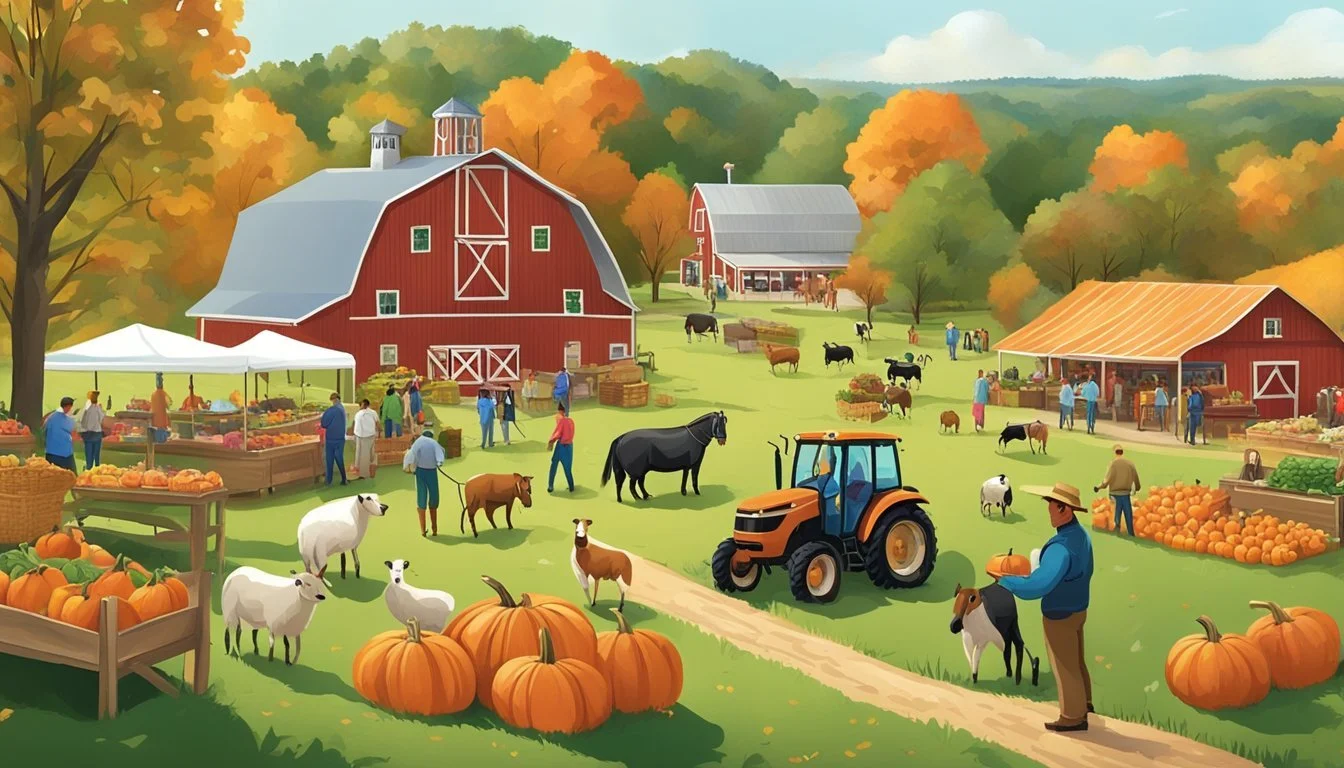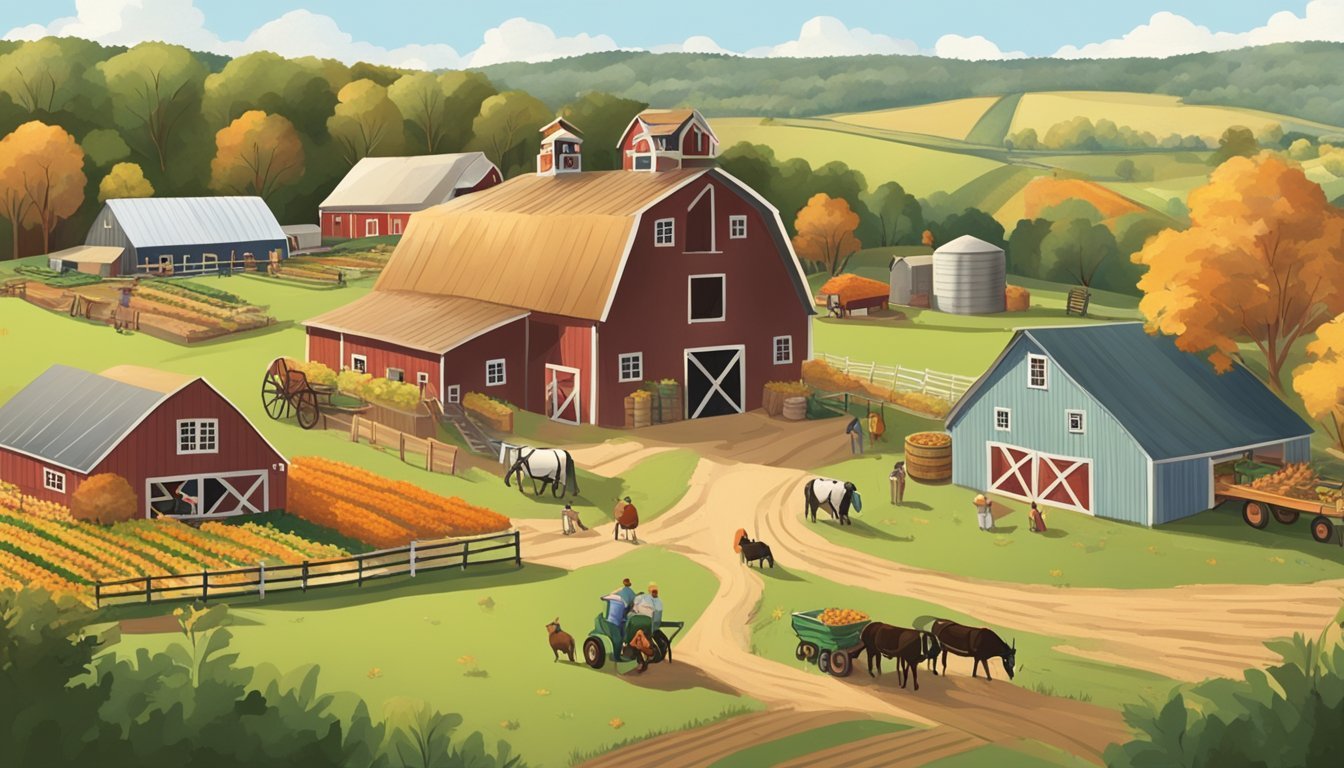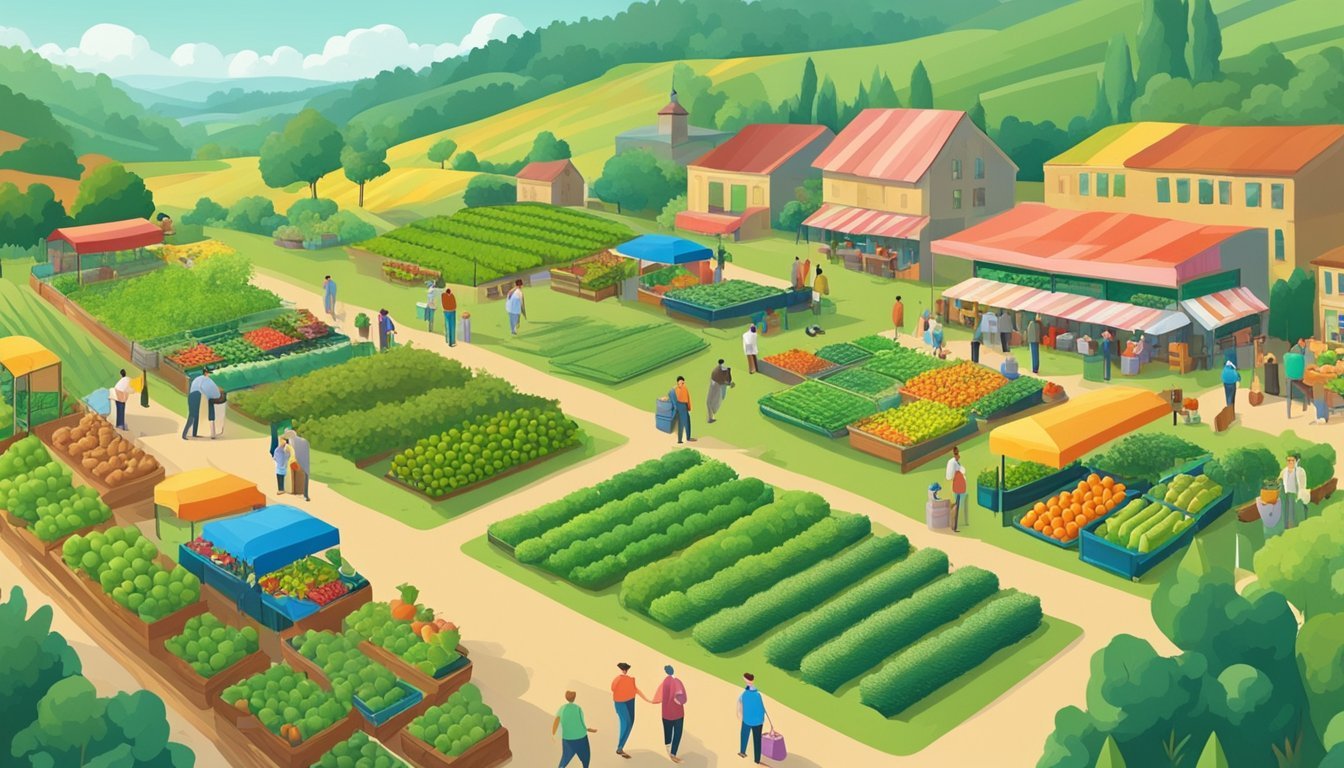Agritourism in Connecticut
Embracing Rural Charm and Farm Fresh Experiences
Agritourism in Connecticut represents an integration of agriculture and tourism, offering visitors an opportunity to experience the state's rich farming heritage and its contribution to the local economy. With over 5,500 farms that not only generate more than $4 billion for the state's economy but also offer a plethora of engaging activities, Connecticut presents a unique combination of educational, recreational, and culinary experiences. This form of tourism allows people to connect with the land and understand the source of their food through activities like oyster tours, apiary visits, and farm stays.
Connecticut's diverse agritourism venues provide a variety of interactions with the farming world. Visitors can enjoy the fresh taste of local produce directly from the farms, engage in educational tours that illustrate the intricacies of farming, or partake in recreational activities set in bucolic landscapes. For instance, the Hummock Island Oyster Tour showcases the local tradition of oystering along with a boat ride, illustrating a direct connection between the state's maritime culture and its culinary offerings.
The state's initiative, Connecticut Grown, supports local agricultural products in various markets, further highlighting the importance of farms to the regional identity. Agritourism in Connecticut not only offers a gateway to understanding the local agricultural practices and products but also plays a significant role in preserving the farming way of life. Visitors participate in a sustainable economic model that supports small farms and local businesses, contributing to the state's economic vitality.
Overview of Agritourism in Connecticut
Agritourism in Connecticut represents a vibrant intersection of agriculture and tourism, contributing significantly to the state’s economy. The Constitution State boasts approximately 5,500 farms, underpinning a sector that infuses over $4 billion into the local economy. These farms offer a diverse range of agritourism activities that appeal to various interests and palates.
Economic Development through Agritourism Agritourism serves as a growth catalyst for Connecticut's economic development, allowing local farms to diversify income streams while providing educational and recreational opportunities to visitors. The direct sales component allows consumers to purchase fresh produce directly from the farms, bolstering farm revenue and fostering community engagement.
Agritourism Activities Here are the five main categories of agritourism activities found in Connecticut:
Direct Sales: Consumers engage in transactions straight from the source.
Education: Includes farm tours and school-related educational experiences.
Hospitality: This can range from farm stays to on-farm dining experiences.
Outdoor Recreation: Encompasses a variety of outdoor farm-related activities.
Entertainment: Constitutes on-farm events like festivals and gatherings.
These categories highlight Connecticut's agritourism's multifaceted nature, from the oyster tours along the shoreline to the pick-your-own orchards. Farm-to-table dinners (What wine goes well with dinner?) present a unique dine-at-the-farm experience, as seen in the "Max's Chef to Farm Dinners" or the "Dinners at the Farm" series, which typifies the state’s dedication to locally grown flavors.
Connecticut’s agritourism confidently engages visitors with the state's rich agricultural heritage, offering immersive experiences that support farms and provide an economic boon to the region.
Starting an Agritourism Farm
In Connecticut, starting an agritourism farm necessitates a clear understanding of local regulations, exploring diversification and funding opportunities, and establishing strong connections within the community.
Zoning and Regulation Compliance
Connecticut's zonal laws may vary by municipality, and farmers must ensure they are compliant with both state and local zoning ordinances. Seeking clarification from local authorities can provide guidance on permissible agritourism activities. Additionally, understanding state-level regulations that pertain to health and safety standards is fundamental for a farm's operation and for protecting consumers.
Diversification and Funding Opportunities
Farmers in Connecticut can bolster their revenue through diversification, incorporating agritourism activities like farm-to-table events, pick-your-own produce, or educational tours. Funding can be accessed through various channels such as state-administered grant programs designed to support local agriculture. These programs often aim to assist farms in expanding their operations to include agritourism.
Connecting with the Connecticut Community
A successful agritourism farm in Connecticut should forge a strong bond with the community. Participation in local farmers markets provides visibility and builds relationships with residents and other local producers. Additionally, the farm can become a destination that contributes to the local economy by offering unique experiences and products that resonate with both residents and visitors.
Popular Agritourism Attractions and Activities
Connecticut's agritourism scene offers a range of activities for all ages, immersing visitors in hands-on agricultural experiences. From ripe orchards ready for picking to educational tours that offer insight into farming practices, each activity provides a unique way to connect with the state’s agricultural heritage.
Pick-Your-Own Experiences
Many farms in Connecticut invite visitors to immerse themselves in pick-your-own experiences, where they can select from a variety of produce like apples (how long do apples last?), pumpkins, pears, and a range of berries including strawberries and raspberries. This activity not only supports local agriculture but also provides families with an enjoyable outing in the countryside.
Orchards: Ideal for apple and pear picking when in season.
Berry Farms: Offer a selection of strawberries and raspberries during the warmer months.
Pumpkin Patches: Open in autumn, perfect for finding that ideal pumpkin.
Farm-to-Table Events
Farm-to-table events connect visitors with the source of their food through dinners, events, and parties held on the premises of local farms. The events often feature locally sourced ingredients prepared by skilled chefs.
Dinners: Showcase seasonal specialties and fresh flavours.
Tastings: Introduce a variety of farm-produced products, from cheeses to wines.
Educational Tours and Workshops
Farms provide tours and workshops that educate visitors on modern and traditional farming techniques. These engagements often include a history of local agriculture and may feature aquaculture, as seen in Connecticut's oyster tours.
Farm Tours: Often include an overview of the farm's operations.
Workshops: Provide practical skills, such as cheese making or sustainable farming methods.
By partaking in these agritourism activities, visitors gain a deeper understanding and appreciation for Connecticut's rich agricultural landscape.
Types of Agritourism Farms in Connecticut
Connecticut’s agritourism offers a diverse landscape of farm experiences, from seasonal produce harvesting and educational farm tours, to dairy farm visits replete with fresh dairy products. This variety allows visitors to connect with the state's rich agricultural heritage and its current practices.
Crop Farms
Crop farms in Connecticut present a wide array of produce for visitors to engage with, often through pick-your-own experiences. They specialize in a variety of fruits and vegetables such as apples, beets, carrots, cucumbers, lettuce, potatoes, and tomatoes. Many farms also offer seasonal delights like corn and pumpkins, especially during autumn festivities.
Fruits: Apples, winter squash
Vegetables: Beets, carrots, cucumbers, lettuce, potatoes, tomatoes
Livestock and Dairy Farms
Dairy farms in Connecticut invite visitors to learn about livestock care and dairy production, often providing fresh dairy products like milk, cheese, and eggs. Apart from dairy cows, some farms raise chickens for eggs, goats for cheese, and even bison (What wine goes well with bison?). These agritourism locations may also offer educational tours that demonstrate the sustainable practices for raising animals.
Dairy Products: Milk, cheese
Livestock: Chickens (eggs), goats, bison
Specialty Farms and Orchards
Agritourism in Connecticut extends to specialty farms, that can encompass vineyards producing a selection of wines, orchards with a variety of fruit trees, and greenhouses nurturing an assortment of herbs and flowers. These sites often provide tours and tastings, while some may incorporate aquaculture or beekeeping for honey production, catering to niche interests of visitors and providing unique, on-farm experiences.
Orchards/Vineyards: Apples, wine production
Specialty Products: Herbs, honey (from beekeeping)
Seasonal Highlights in Connecticut Agritourism
Connecticut agritourism offers a variety of seasonal activities that cater to visitors looking for authentic farm experiences. From the vibrant fall harvest to the cozy winter festivities, each season has its own unique events and produce to enjoy.
Fall Festivities and Harvest Events
During the fall, Connecticut's farmlands burst with the colors of autumn, providing a picturesque backdrop for harvest-time activities. Scantic Valley Farm becomes a hub for those seeking the quintessential fall experience.
Pumpkins and Apple Picking: Farms across the state host pumpkin picking and apple harvesting, where visitors can select the perfect pumpkin for carving or gather fresh apples for pie-making.
Corn Mazes: Navigate the twists and turns of intricately designed corn mazes—a fun challenge for families and friends.
Fall Produce: In addition to pumpkins and apples, farms offer a bounty of winter squash and other seasonal produce.
Visitors can find an array of fall events, including weekend festivals featuring hayrides, farm-to-table meals, and local artisanal crafts.
Winter and Christmas Specials
As the chill of the winter season sets in, Connecticut farms transform into festive wonderlands.
Christmas Trees: Local farms offer a selection of Christmas trees, with some providing the option to choose and cut your own tree, ensuring a fresh centerpiece for holiday celebrations.
Maple Syrup: With the arrival of colder weather, it's also maple syrup time. Visitors can learn about the sugaring process and taste the rich flavor of freshly harvested maple syrup.
Holiday Events: Many farms host special events where guests can enjoy the spirit of the season—think winter markets, bonfires, and horse-drawn sleigh rides.
Agritourism in Connecticut doesn’t hibernate; instead, it embraces the crisp air and the warmth of holiday cheer, inviting guests to make lasting winter memories.
Marketing and Promoting Agritourism
Agritourism in Connecticut thrives on efficient marketing and strategic promotion, capitalizing on social media trends, the state's abundant farmers’ markets, and the strength of the "Connecticut Grown" brand.
Leveraging Social Media and Local Networks
In Connecticut, agritourism businesses tap into local community networks and social media platforms to widen their reach. By showcasing their offerings through visual content on Instagram, live tours on Facebook, and using targeted hashtags like #CTGrown, they engage directly with potential visitors. Social media not only serves to attract visitors but also fosters a community around Connecticut’s agritourism.
Participation in Connecticut Farmers' Markets
Connecticut’s farmers’ markets are valuable venues for agritourism entities to promote their experiences and products. They serve as interaction points where farms can connect with consumers and other local vendors, increasing their visibility. Through participation, they also reinforce the Connecticut Grown identity, celebrating the state’s rich agricultural produce.
Building a Brand Around Connecticut Grown
Effective branding is crucial for agritourism businesses in Connecticut. Emphasizing the "Connecticut Grown" identity in marketing materials — from brochures to website design — helps businesses differentiate themselves. It instills confidence in consumers about the quality and origin of their offerings. This commitment to local branding echoes throughout their promotional strategies, ensuring that visitors associate their experiences with the authentic Connecticut farm life.
Sustainability and Agricultural Preservation
In Connecticut, the intersection of sustainability and agricultural preservation is pivotal to securing the sector's longevity. These initiatives are aimed at nurturing the environment while bolstering the agricultural community's economic viability.
Land Conservation Efforts
Connecticut has made substantial strides in farmland conservation. The Connecticut Department of Agriculture's Farmland Preservation Program set an ambitious goal to preserve 130,000 acres of farmland to safeguard the future of agriculture. As of 2020, more than 45,300 acres have been preserved, signaling the state's commitment to land stewardship.
Key Tactics:
Purchasing Development Rights (PDRs) to ensure land remains available for agriculture
Incentivizing farms: Financial encouragement for farmers to keep land in agricultural use
Educational Programs: Raising awareness among the public about the benefits of land conservation
Sustainable Farming Practices
Connecticut's agricultural community actively adopts sustainable farming practices to reduce environmental impact and enhance food security. Greenhouse usage has surged, providing controlled environments for year-round crop production while using fewer resources. Sustainable techniques such as crop rotation, reduced chemical inputs, and responsible water management are widely practised to ensure long-term viability of the farmland and aquacultural resources.
Highlights of Sustainable Practices:
Crop Rotation: Enhancing soil health and mitigating pests and diseases without chemicals
Aquaculture: Utilizing closed-loop systems that recirculate water, minimizing waste and environmental impact
Energy Efficiency: Farms incorporating green technology to reduce their carbon footprint
Economic Impact of Agritourism
Agritourism has emerged as a pivotal element in Connecticut's economy, effectively influencing local revenue and employment. Through direct sales and multifaceted experiences, agritourism drives economic development and skill diversification.
Boosting Local Economy
Connecticut's agritourism is not just a leisure activity; it's a potent economic driver. Studies indicate that in 2015, local agricultural industry food sales combined with agritourism contributed significantly to the state's economy. Specifically, agritourism provides a reliable stream of revenue by attracting visitors who spend on accommodations, dining, and local products, enhancing the financial health of rural areas.
Direct Sales Revenue: Agritourism participants often purchase products directly, cutting out the middleman and funneling money straight into the local economy.
Enhanced Market Visibility: Connecticut agritourism elevates the profile of local products, fostering brand loyalty and potentially claiming higher price points for quality and experience.
Job Creation and Skill Development
The infusion of agritourism invites a spectrum of jobs, from hands-on agricultural work to customer service positions, fueling job creation and offering skill development opportunities.
Employment Opportunities: The operation of agritourism ventures necessitates a variety of job roles, including tour guides, product demonstrators, event coordinators, and marketing specialists.
Skill Diversification: Employment in agritourism enables individuals to develop a broader skill set, incorporating agriculture, business acumen, customer service, and even digital marketing, ensuring that the workforce can adapt to the evolving demands of the job market.
Challenges Facing Connecticut Agritourism
Agritourism in Connecticut faces unique challenges that stem from reliance on seasonal weather patterns and the necessity of integrating tourism seamlessly into day-to-day farm operations.
Weather Dependencies and Risks
Connecticut's diverse weather can significantly impact agritourism. Not only do seasonal changes dictate the timing of festivals and outdoor events, but unexpected weather events like storms or droughts can derail planned activities. Farmers must employ risk management strategies to mitigate these potential disruptions.
Key Risks:
Storms may damage infrastructure or crops.
Excessive rain or drought can lead to cancellations.
Effective planning around these dependencies is crucial to ensure the sustainability of agritourism ventures in the region.
Balancing Tourism with Farm Operations
As Connecticut farms open their doors to tourism, they face the challenge of balancing the increased workload management without interfering with essential farm operations. Agritourism requires staffing, resource allocation, and sometimes different insurance and regulatory considerations. Balancing these additional responsibilities with the demands of agriculture is a critical skill for Connecticut farmers.
Critical Balancing Acts:
Ensuring tourism activities do not disrupt farming practices.
Managing visitor expectations while conducting regular farm operations.
Handling the dual demands of agriculture and tourism is a delicate endeavor that necessitates effective operational planning and workload delegation.
Future of Agritourism in Connecticut
The future of agritourism in Connecticut looks promising with a strong emphasis on innovation and technology driving growth. These elements are crucial for the evolution of the industry within the state.
Innovative Practices and Growth
Connecticut's agritourism is on a trajectory of growth, fueled by innovative practices that attract visitors looking for unique, hands-on experiences. Farms across the state are diversifying their operations, incorporating activities like pick-your-own produce, culinary classes, and farm-to-table dinners. It's this blend of traditional agriculture with creative hospitality that positions Connecticut's agritourism for continuous expansion.
The Role of Technology in Agritourism
Integrating technology in agritourism is key to enhancing visitor engagement and operational efficiency. Connecticut farms are increasingly using social media to market themselves and mobile apps to provide on-site educational experiences. Furthermore, the adoption of advanced technologies such as drones for virtual farm tours and online platforms for bookings has not only streamlined visitor experiences but also broadened the reach of agritourism in Connecticut.









